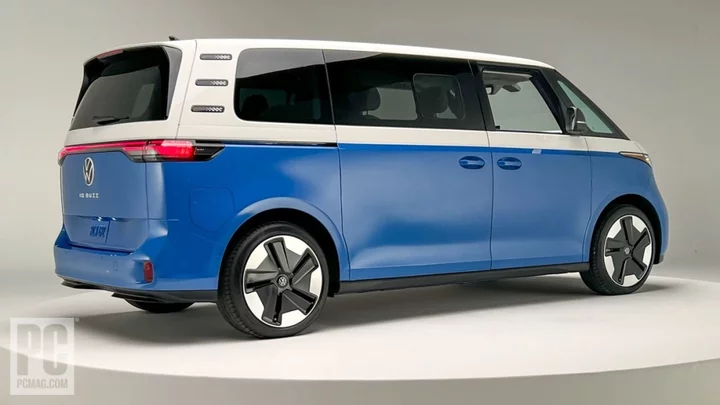HUNTINGTON BEACH, Calif.—While electric vehicles like the Hyundai Ioniq 5 and Rivian R1T rely on futuristic styling, and the Ford F-150 Lightning sticks with a traditional modern-truck look, the exterior design of Volkswagen’s new ID. Buzz pays homage to the classic VW Microbus—an iconic vehicle that conjures images of '60s counterculture. But underneath the nostalgic sheet metal of the ID. Buzz is a thoroughly modern electric powertrain, and inside is an innovative and inviting space with room for seven passengers.
VW unveiled the 2024 ID. Buzz in Huntington Beach, paying tribute to the van’s roots as a surf wagon and California coastal icon. The three-row vehicle has a longer wheelbase than the two-row European model that VW says makes it tailored to the North American EV market. Like the original Microbus, the ID. Buzz has a rear-mounted motor, while the battery resides under the floor skateboard-style to save space and allow its weight to aid in handling via a low center of gravity.
The ID. Buzz will go on sale next year and come standard with rear-wheel drive and a 91kWh battery that produces 282 horsepower. An available all-wheel drive version with dual motors—one at each axle—will produce about 330hp with the top speed electronically limited to 99mph.
Modernized Retro Design
The retro exterior design cues include a large and lighted VW logo on the vehicle’s short snout, wraparound windows, D-pillar air vents that replicate the Microbus’ rear-engine cooling slots, and two-tone colors available in six hues.
Nostalgic touches continue in the interior with the Microbus’s classic sliding windows—albeit fully powered—and second- and third-row seats that fold flat to create a sleeping surface. The third row can also be entirely removed.
Other aspects of the interior such as a 12.9-inch dashboard infotainment display, 5.3-inch digital instrument cluster, large electrochromic sunroof, and standard ambient lighting with 30 colors and five mood presets, mark the ID. Buzz as contemporary. Small, embossed ID. Buzz silhouettes in the rear-seat side panels and on the base of the second seat, and a brake pedal and accelerator with stop and play symbols, give the interior a sense of whimsy, while removable section dividers in the center console—which itself is also removable—double as a bottle opener and an ice scraper.
Price, Range, and Charge Times to Come
Volkswagen didn’t reveal pricing, range, or charge times of the ID. Buzz, but based on the automaker’s ID.4 EV, we expect range to be north of 250 miles and Level 3 DC fast-charging to replenish the battery from 20% to 80% in about 40 minutes with comparable Level 2/220V charging to take about 8 hours.
We didn’t get a chance to drive the new ID. Buzz, but did get a spin in the vehicle with a VW representative at the wheel and were impressed by the high seating position, smooth and quiet ride, instant acceleration, and all the attention the van gets. The interior is more refined and flexible than the prototype we saw and rode in last year, although the infotainment and driver-assist features in the production-ready van seem basic.
In the current EV climate with either ultramodern or basic exteriors—and omnipresent Teslas—the 2024 VW ID. Buzz’s classic design stands out, while its interior provides space, flexibility, and quirkiness no other EV matches. We can’t wait to drive it and see how it stacks up to the best EV brands in on-road performance, comfort, everyday utility, and emission-free driving.

